Overview
Kelp are large brown algae that under the right conditions can grow up to 18 inches per day, creating incredibly productive underwater forests. Found in many shallow, nearshore areas along the west coast of North America and within four national marine sanctuaries, kelp forests form important habitat for thousands of species of fish, invertebrates and marine mammals. Kelp forests thrive in cold, nutrient dense water and harbor a greater diversity of organisms than almost any other ocean ecosystem. Similar to forests on land, kelp forests undergo seasonal changes and thrive when conditions are ideal. There are two primary, canopy-forming species along the west coast that form the foundation of kelp forests: giant kelp and bull kelp. In some areas one type of kelp is dominant (bull kelp in northern California , giant kelp in southern California), in other areas both types of kelp are mixed (central California and Washington).
Kelp forests are susceptible to negative impacts from climate change, pollution and invasive species. Along northern California within Greater Farallones National Marine Sanctuary, kelp forests have declined by greater than 90% in just a few years, causing devastating ecological and economic impacts. There are efforts along the entire west coast to monitor, research and restore kelp forests and there are several ways you can be involved in protecting these special habitats. Here we will explore the importance of kelp forests, what threats impact kelp forest habitat, what ongoing scientific, management and conservation efforts are happening with kelp forests and how you can help!
The Importance of Kelp Forests
Kelp forests are ecosystem engineers, meaning they provide habitat, structure, and food for hundreds of thousands of species. This makes kelp forest ecosystems a biodiversity hotspot. Many of the species that kelp forests support are commercially, recreationally, and culturally important. Examples of these species include: abalone, sea urchins, crabs, marine mammals and various fishes. Kelp forests dissipate storm energy, thus helping to protect coastlines from erosion and degradation. Kelp forests help to absorb excess terrestrial runoff. In doing so, it helps to prevent harmful algal blooms. As primary producers, kelp takes in carbon dioxide from the atmosphere and performs photosynthesis to produce oxygen. This photosynthetic activity and growth serves as the base of a very complex and biodiverse food web. Kelp forests also play a critical role in sequestering carbon from the atmosphere and have the potential to locally mitigate ocean acidification.
The benefits created by kelp forest ecosystems affect ecological communities that are close and far away. When kelp detaches from its holdfast, it moves to other parts of the ocean where it provides additional ecosystem services. As it moves to different locations, it provides habitat, food, and protection for a myriad of species. Floating kelp rafts provide shelter and food for pelagic species, especially juvenile fish and seabirds. Beach wrack, or “patches” of kelp that wash onshore, create an ephemeral, productive community on sandy beaches. Beach hoppers feed on beach wrack at night and burrow underneath it during the day for shelter. Seabirds and shorebirds feed on these invertebrates and when the wrack breaks down into smaller debris, it provides habitat for migrating birds to roost and rest. Eventually beach wrack decomposes completely and provides nutrients for dune plants. Detached kelp is also important for the deep ocean. Transport of detached kelp to the deep ocean provides food for deepwater organisms and is an important way in which carbon absorbed by kelp is sequestered.
Kelp and urchin dynamics
Rocky reef habitat along the west coast of the US can have either kelp or urchins dominating the reef biota. In some cases, sites are in transition between these two dominant states.
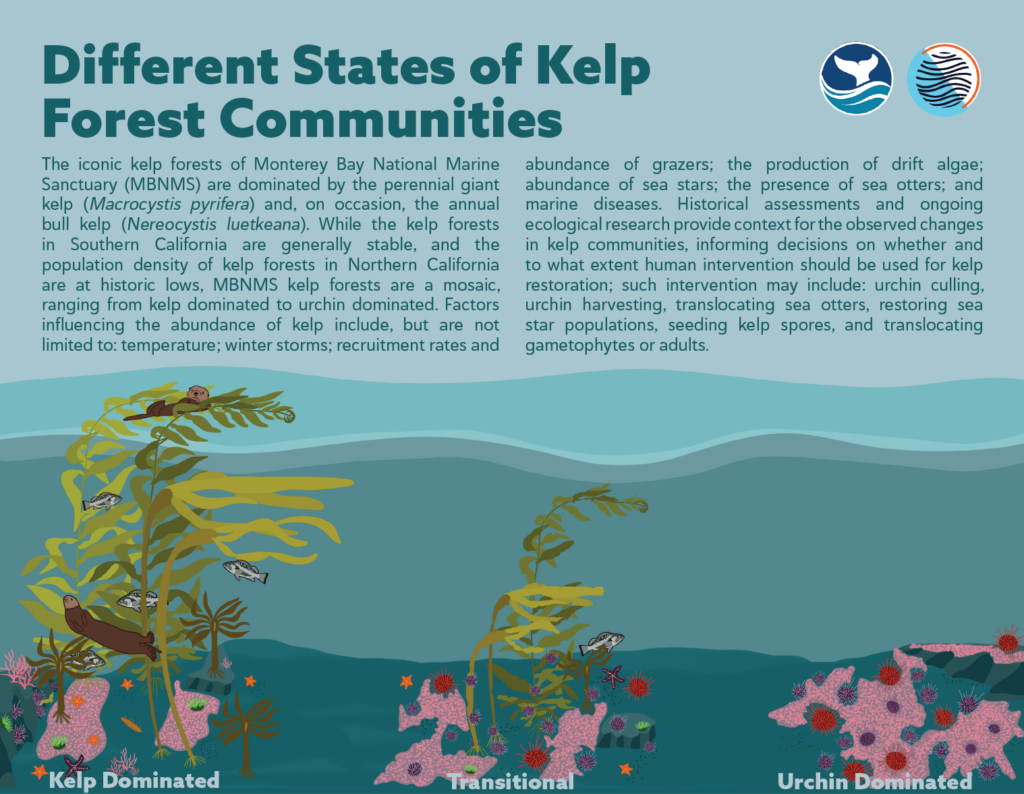
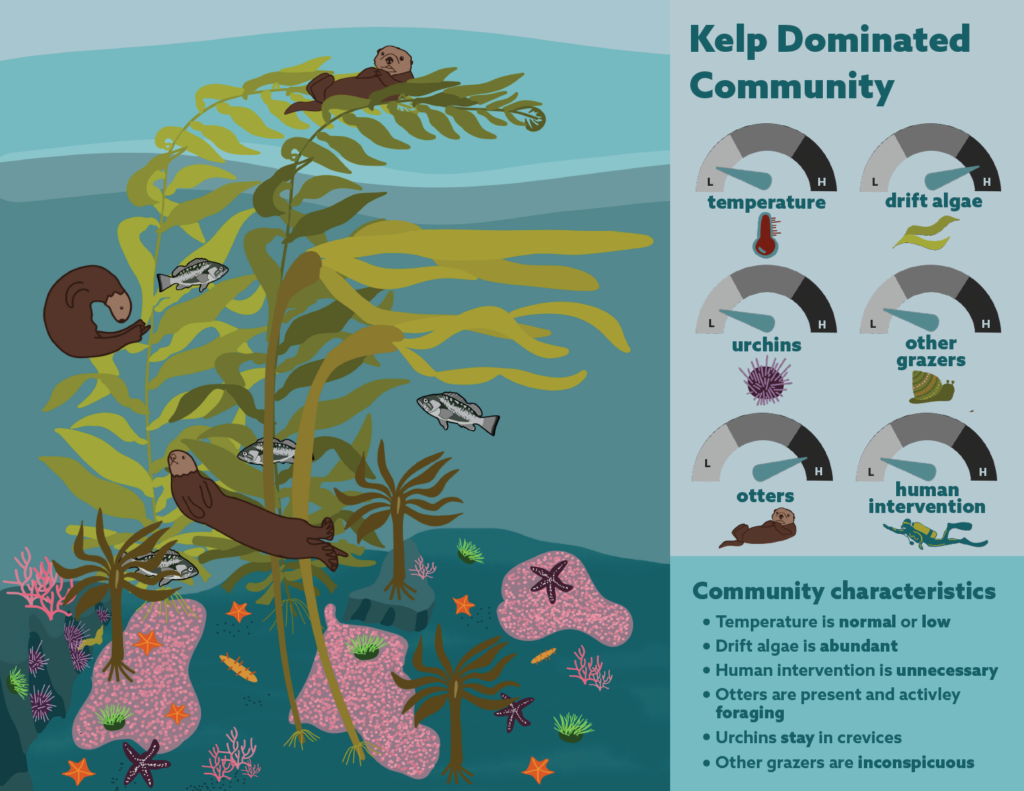
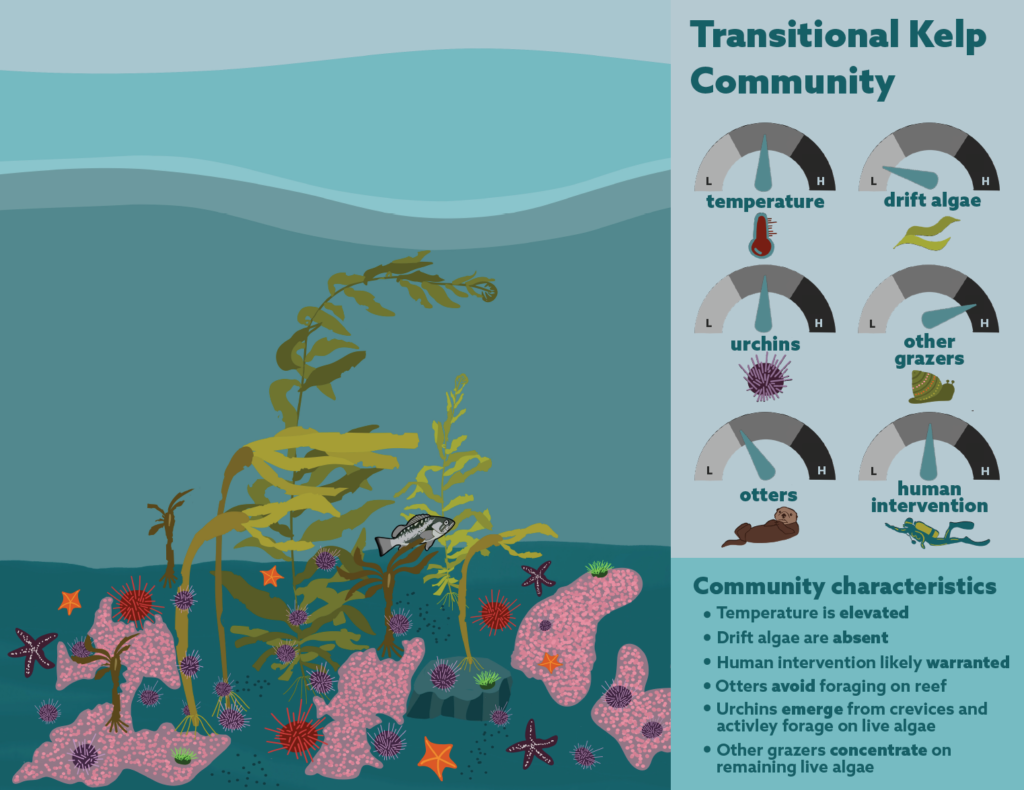

Causes & Consequences
First and foremost, it is important to understand the best conditions in which kelp forests thrive. None of these factors act in isolation – rather is the combination of all of these elements that yield a successful and healthy kelp forest ecosystem. It is when these factors are altered that we see kelp forest loss.
Kelps naturally occur and thrive in areas with high wave action. However, too much wave action will rip kelp from its holdfast. Thus, the amount of wave energy may limit the growth of kelp in shallow areas. Each species of kelp can tolerate differing levels of wave action. This plays a large part in determining the types of kelp that make up the zones for inshore, canopy, and further offshore populations. Temperature is considered optimal in subpolar and temperate regions, as kelp forests thrive in cold water. High nutrient levels are necessary for primary production, so kelp forests typically occur in global areas consistent with upwelling, the process by which cold, nutrient-rich water from the bottom of the ocean comes to the surface. Light penetration is important in determining the deeper limits of kelp growth. Increased sedimentation (sand and dirt) mixed in ocean water can result in scouring, light reduction, and burial. All of these factors affect the survival of juvenile gametophytes and sporophytes (baby kelps!).
Invertebrates and other species of algae also grow on vertical and horizontal surfaces underwater, causing a competition for space. When maintained in the right balance, the grazing pressure of urchins on kelp is primarily limited to detached or drifting pieces of kelp. However, when drift kelp is limited, such as when ocean temperatures are warmer than usual and kelp growth is suppressed, urchins can change to actively grazing live kelp. Overgrazing by urchins can cause a kelp forest ecosystem to shift out of balance and become an urchin barren, or an area of high urchin density and low biodiversity, impacting the entire nearshore food web.
Kelp loss can be impacted on both a global and local scale. However, while some regions have experienced extensive loss of kelp forests (such as northern California), while other regions have not experienced net kelp loss other than natural seasonal dynamics (such as Washington’s outer coast). We will explore the local drivers of kelp loss in greater detail.
Globally, kelp loss can be attributed to:
- Large-scale climatic variations – May influence factors such as storm frequency and severity (such as the El Niño Southern Oscillation (ENSO)), as well as oceanic processes such as upwelling.
- Species Loss and Overfishing – Loss of one or more species can result in trophic cascades throughout the kelp forest ecosystem.
- Pollution – Nutrient pollution induces harmful algal blooms and decreases light availability.
- Invasive species – Will oftentimes outcompete native species. As a result, local biodiversity is lost.
Locally, kelp loss is largely attributed to marine heatwaves and increased grazing pressure by urchins. Marine heatwaves are periods of increased ocean temperatures that may limit nutrients needed for kelp growth. Once conditions are conducive to urchin population growth, a kelp forest ecosystem may shift entirely to an urchin-dominated system, or what is commonly referred to as an “urchin barren”. Urchin barrens are considered an alternative stable state to kelp forests and have been observed to persist for longer than 80 years in regions along the North Pacific and Atlantic Ocean. Some regions, such as the northern coastline of California, may be more vulnerable to these ecosystem shifts due to the absence of keystone species, such as sea otters and sunflower stars, which in a healthy kelp forest are likely to contribute to overall stability of the ecosystem.
Marine heatwaves
As a result of climate change, the frequency of marine heatwaves are increasing in severity and duration. In 2013, the Northeast Pacific Ocean (NPO) experienced the greatest Sea Surface Temperature (SST) anomaly since the 1980’s. It was coined “The Blob” and lasted for over 711 days. The cause of this marine heatwave was likely the combination of the (ENSO) coupled with the persistent high-pressure ridge over the NPO, the same weather pattern that caused an extended drought in California.
Upwelling
Upwellingis an extremely important process for kelp forests, as it is responsible for the transport of cold, nutrient-rich water to the surface. Upwelling is influenced largely by atmospheric conditions such as winds and the coriolis effect. In the northern hemisphere, the coriolis effect and winds result in a deflection of surface waters to the right, off our coastlines. As the warmer surface water deflects off, the colder, nutrient-rich waters from the deep move up to the surface to take its place. The result is an increase in nutrients and a boom in productivity. However, as atmospheric conditions change and become less predictable as a result of climate change, the timing, distribution, and magnitude of upwelling is being affected. Additionally, warmer SST and ENSO are impacting the thermocline and California Current, which may suppress upwelling off our coastlines. Without this transfer of nutrient rich water, primary productivity is decreased, resulting in a mass mortality of kelp forest communities.
Increased Grazing Pressure by Urchins
In northern California, purple urchin populations have expanded exponentially. As a result, their feeding behavior has become more aggressive. In large numbers, they are able to decimate entire areas where a productive kelp forest once stood. The occupation of urchins into an area once predominated by kelp is called an urchin barren. In this alternative stable state, the growth of new algae is unlikely. Research indicates that urchin barrens may persist for decades. In order to shift the ecosystem back into a kelp-dominated community, urchin numbers must be reduced to allow for the growth of new kelp.
Sea Star Wasting Syndrome
In 2013 and 2014, an outbreak of Sea Star Wasting Syndrome (SSWS) led to a massive death of sea stars along the coast of the Northeast Pacific. The exact cause of this disease is not yet completely understood. However, there is speculation that the combination of a viral pathogen and environmental conditions led to its exacerbation and rapid spread. A minimum of 20 sea star species experienced extremely high mortality rates along the West Coast of North America. In the Sonoma-Mendocino County area, the sunflower star (Pycnopodia helianthoides)was hit particularly hard. The health of this species is important, as it is one of the few predators of the juvenile purple urchin. Studies show that between 2014 and 2018, there is a negative correlation between sunflower star populations and purple urchin populations. This suggests that the die off of the sunflower star as a result of SSWS,may have contributed to a boom in purple urchin populations. However, kelp loss did not occur in all areas where sunflower stars declined, so these events are not necessarily directly related. As of late 2020, the sunflower star was declared critically endangered by the International Union for Conservation of Nature (IUCN).
Sea Otter Extirpation
Northern and Southern sea otters are a keystone species in kelp forest communities, meaning they help control the population of herbivorous invertebrates grazers. Studies of the ecological influence of sea otters on kelp forests shows that they may play an important role in maintaining the overall health and stability of the ecosystem. Following the fur trade in the 1900’s, the sea otter was extirpated from the northern California coastline.
A smaller subpopulation of sea otters exists in Monterey Bay. Despite the occasional sighting in the San Francisco Bay, there are no abundant otter populations in northern California.
Consequences of Kelp Forest Loss
Ecological impact: As mentioned, kelp forests act as habitat, shelter, protection, and food for thousands of species. Kelp acts as the structural integrity that holds together an extremely biodiverse and complex ecosystem. Thus, if you take away the core structural unit, the rest may ultimately collapse as well. Not only does the collapse of this ecosystem affect thousands of marine species, it also has a strong influence on coastal communities. In some areas, kelp forests (especially giant kelp) may act as a wave buffer to help to dissipate the energy from large, breaking waves. Without kelp, our coastlines are at further risk of coastal erosion and degradation. Given that storm severity and frequency is expected to increase with climate change, a natural wave buffer may help protect our coastlines.
Economic impact: Kelp forests provide habitat for many economically important species along the west coast. Recent declines in bull kelp has already impacted two economically significant species: the red urchin and the red abalone fisheries. In northern and southern California, kelp forests historically supported the red urchin fishery. Red urchins rely on kelp for food. However, given the widespread decline of bull kelp, red urchins have no food source and are left in starving condition—unable to be harvested for commercial or recreational use. At its peak, the economic value of the red urchin fishery in the Sonoma-Mendocino county area was $3 million. The loss of this fishery has serious economic consequences, especially for fishermen in coastal communities.
After the collapse of the red abalone fishery in southern and central California, the northern California recreational red abalone fishery provided the only outlet to fish abalone in California. At its peak, this fishery brought in more than $44 million per year. However, starting in the 2000’s, populations of red abalone began to decline drastically. Mortalities were associated with starvation, as a result of their food source (algae) becoming more and more scarce. In 2018, the California Fish and Game Commission closed the recreational red abalone fishery, as the population density was below the fishing threshold of 0.3 abalone per meter squared. The few surviving red abalone have been seen closer to shore, where they graze on a limited algal supply in shallower waters. Unfortunately, their proximity to shore makes them more susceptible to consequences of large waves, runoff and pollution. This fishery will be closed until 2021, when conditions will be re-examined.
Social and cultural impact: Cultural practices of coastal tribal nations are often heavily intertwined with kelp forest species. Culturally important species include over 150 types of marine fishes, seaweeds, and shellfish such as crabs, mussels, abalone, clams, oysters, chitons, and other gastropods. Used in tribal songs, ceremonies, rituals, and dances, the vitality of these organisms is dependent upon a healthy kelp forest ecosystem. Significant loss of kelp forests negatively impact these species and endanger tribal traditions.
Urchin identification
Sea urchins are important herbivores in kelp forest ecosystems. When maintained in healthy numbers, they passively graze on pieces of kelp that have already broken off from the thallus. However, when their populations go unchecked, they adopt a more “active” feeding style. In this manner, they graze directly on the thallus, eventually breaking off the stipe from its holdfast. This type of behavior is harmful to kelp forests, as it often leads to the shift from a once healthy and plentiful kelp forest to an urchin dominated ecosystem, called an urchin barren.
Urchin Identification Guide
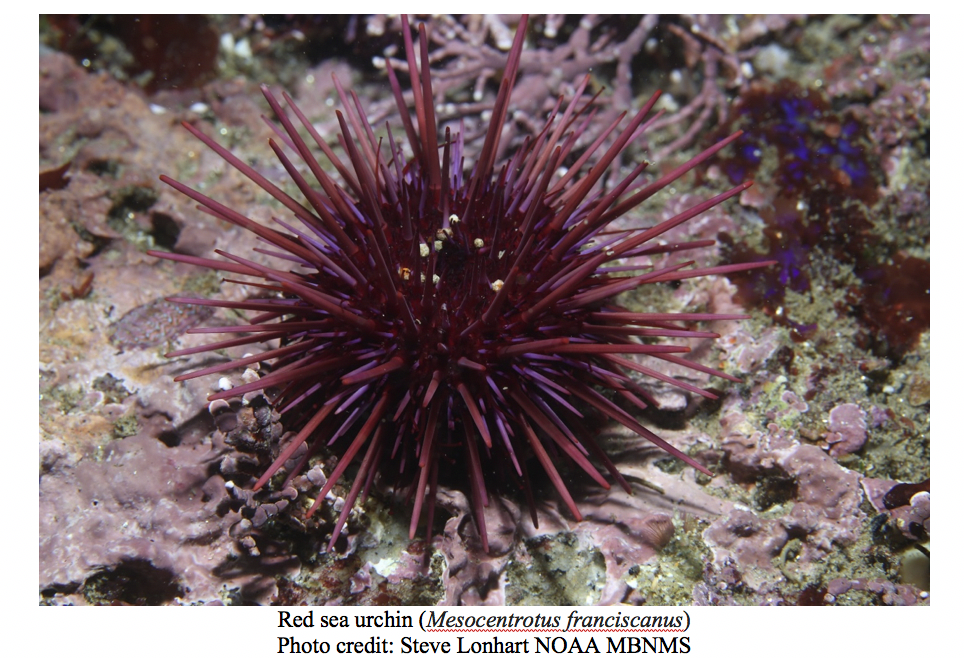
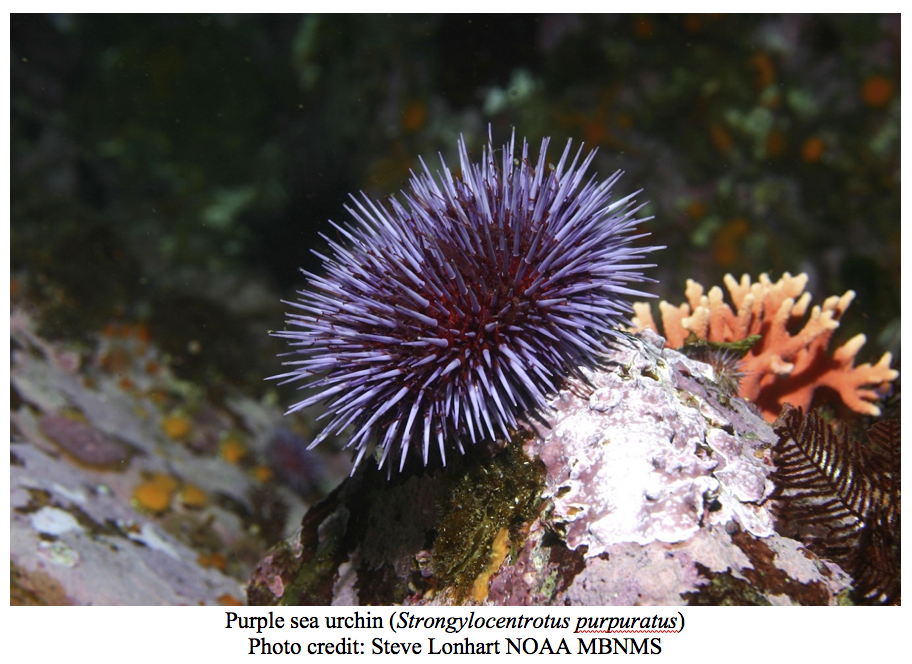
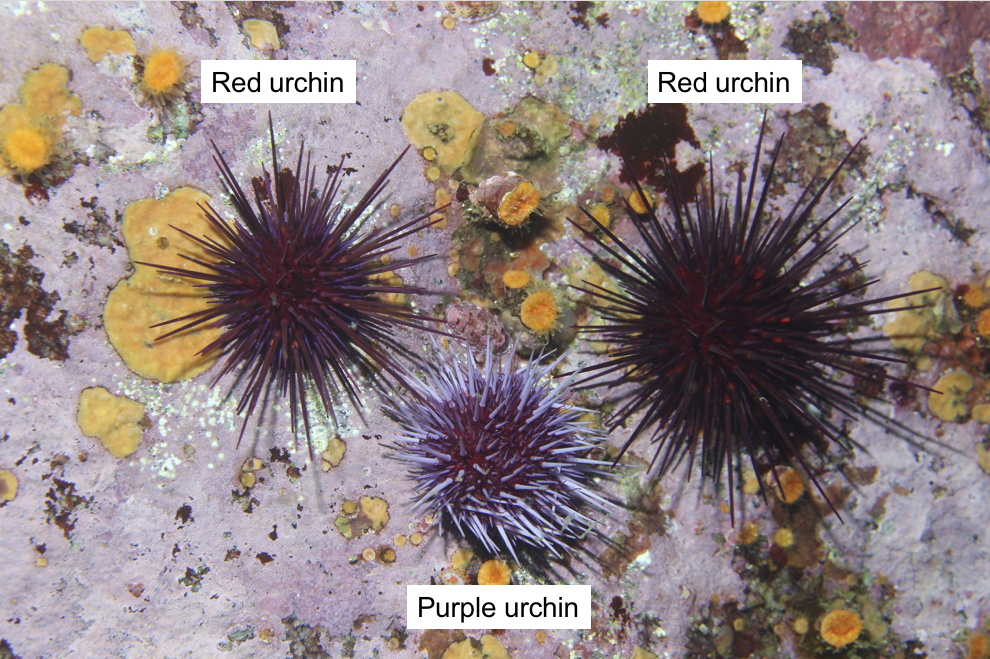
Kelp restoration & science
Kelp forest restoration is a narrow field in terms of practical, on the ground applications, as restoration work underwater has unique challenges compared to terrestrial restoration. The Bay Foundation is the most comprehensive example of kelp forest restoration that is still happening. They initiated a restoration project in 1997 off the Palos Verdes Peninsula in southern California to reduce the density of urchins on nearshore rocky reefs. By 2009, they had demonstrated that reducing urchin density from 100 urchins per square meter to less than two sea urchins per square meter allowed the natural growth of kelp at restoration sites. On the northern California coastline starting in 2018, the Waterman’s Alliance and the Noyo Center coordinated efforts to pay commercial urchin divers to remove purple urchins at key sites on the north coast of California. In 2020, the Ocean Protection Council dedicated $500,000 to investigate the efficacy of commercial divers in removing urchins as a kelp restoration technique. The project is also investigating whether recreational divers can effectively manage urchin populations via smashing at Caspar Cove in northern California. Beginning in 2021, the recreational community will be able to cull urchins at Tanker’s Reef in Monterey Bay.
Kelp forest monitoring takes place both underwater and on the surface. Organizations like Reef Check, the Partnership for Interdisciplinary Studies of Coastal Oceans (PISCO), NOAA, the California Department of Fish and Wildlife (CDFW) and local universities conduct subtidal dive surveys via SCUBA to count and measure fish, invertebrates and algae. These surveys help provide a snapshot of ecosystem health, especially if they are done in the same locations each year for comparison. Kelp canopy mapping is another important element of gauging kelp forest health and dynamics. Plane-based surveys are conducted annually in the Puget Sound and along the outer coast within Olympic Coast National Marine Sanctuary. In California, plane-based surveys have provided historical data for kelp canopy, but have proved to be too expensive in recent years. Landsat has been used to create a thirty-year time series for giant kelp and is being explored as a tool to map bull kelp. Finer scale mapping by Uncrewed Aerial Systems (UASs) is being done on the north coast of California at sites outlined in the Sonoma-Mendocino Bull Kelp Recovery Plan. The Greater Farallones Kelp Recovery Program is leading an effort to conduct a sensor comparison, outline resources and coordinate sharing of information for west coast sanctuaries to improve kelp canopy monitoring efforts.
Universities, private institutions, nonprofits and government agencies all along the west coast are engaged in kelp forest research. In 2020, $2.1 million was dedicated by California Sea Grant, the Ocean Protection Council, and the California Department of Fish and Wildlife to six projects focused on investigating methods to restore kelp forests. To learn more about these projects, you can visit the Sea Grant website.
Fishing regulations
Always be sure to check current fishing regulations in your area, either through the California Ocean Sport Fishing website or the Washington Fishing Regulations website. Please also be aware of locations and regulations surrounding Marine Protected Areas (MPAs) in Washington and California.
In California, the daily recreational bag limit for purple sea urchin is 35 individuals. In the counties of Humboldt, Mendocino, and Sonoma the daily bag limit for purple sea urchin was increased to forty gallons when taken by skin or SCUBA diving and there is no possession limit. At Tanker’s Reef in Monterey Bay (beginning in April 2021) and Caspar Cove in Mendocino County, purple sea sea urchins may be taken in any number by hand or with manually-operated hand-held tools for the purpose of restoring the kelp forest ecosystem. Red sea urchin may not be taken recreationally at any location, with the exception of Tanker’s Reef in support of the restoration effort. Find out more by visiting the California Department of Fish and Wildlife Recreational Ocean Fishing Regulations website for invertebrate fishing regulations.
Removal vs. Smashing of Urchins
The primary technique for kelp forest restoration that is being investigated on the west coast is urchin population management. There are two ways to manage urchin populations. The first is complete physical removal, or harvesting, of urchins from the ecosystem. The second is smashing, or culling, urchins while underwater. Both methods generally are conducted on SCUBA and have been limited spatially in their utilization. It is challenging to conduct large-scale urchin removal and smashing efforts on a large scale, thus techniques in California in the future may be strategically targeted at specific sites identified to have recovery potential. The intention is that as these smaller patches recover, they will create distributed sources of kelp spore production to expedite broad-scale recovery once ocean conditions improve or there is a large-scale decline in urchin populations by natural processes. Both of these methods have benefits and limitations. As the current studies progress, we will learn more about the advantages and disadvantages of each method and determine how either or both may be utilized for future kelp forest restoration efforts. The most important part of kelp restoration is to be coordinated, thoughtful and strategic.
Urchin removal is more labor-intensive and involves using hand-tools and collection bags, or a modified underwater vacuum called an airlift. Due to the intensity of the work, the necessary equipment, permitting and expertise, urchin harvesting is typically done by commercial urchin fishermen. There is potential for this technique to be utilized on a larger scale with commercial divers and it helps support the livelihoods of commercial fishermen who lost their jobs due to severe kelp loss. However, removal entails a larger budget to pay fishermen for removals and to purchase and maintain equipment.
Urchin smashing involves physical crushing of urchins underwater with hand-held tools with the intention of culling them. Smashing is done both commercially and recreationally in California. Some consider smashing to be a more efficient method than removal, as it requires less equipment, less labor and there is no need for disposal and composting of large amounts of urchins. However, there are some concerns surrounding smashing as a restoration technique. If urchins are reproductively viable, smashing them may release their gametes into the water, causing a potential increase in recruitment (more baby urchins!). It may potentially cause physical damage to the reef, or other invertebrates if the smashing tools are not precisely used. Smashing may cause an unnatural shift in fish foraging behavior as they feed on urchin debris in the water column. There are also concerns that culling a native species may carry a negative message about how to manage ecosystem restoration.
How to get involved
There are many ways to get involved! We recommend you check with individual organizations and groups and learn what opportunities are available. Ways to get involved:
To stay updated on kelp research, monitoring and restoration and opportunities to get involved, you can join the Kelp Ecosystem Landscape Partnership for Research on Resilience (KELPRR), a network that meets once a month to discuss everything related to kelp forests. Members are from throughout California, as well as Washington, and anyone is welcome to join. KELPRR is managed by the Greater Farallones Kelp Recovery Program and you can email Rietta Hohman at rhohman@farallones.org to learn more and join!
Resources
NOAA’s Office of National Marine Sanctuaries
https://sanctuaries.noaa.gov/visit/ecosystems/kelpdesc.html
Olympic Coast National Marine Sanctuary
https://olympiccoast.noaa.gov/
https://olympiccoast.noaa.gov/living/habitats/kelpforest/kelpforest.html
Greater Farallones National Marine Sanctuary
Monterey Bay National Marine Sanctuary
https://montereybay.noaa.gov/sitechar/kelp1.html
Sanctuary Integrated Monitoring Network (SIMoN)
Channel Islands National Marine Sanctuary
Channel Islands National Park
Kelp Recovery Program (Northern California)
Lending a Kelping Hand in Greater Farallones National Marine Sanctuary
Kelp Watch
Giant Kelp Restoration Project
Palos Verdes Kelp Forest Restoration Project
Reef Check California
PISCO – Partnership for Interdisciplinary Studies of Coastal Oceans
California Recreational Ocean Fishing Regulations
Red Abalone Fishery Management Plan
Red Sea Urchin Enhanced Status Report
California Marine Protected Areas
Washington Department of Natural Resources – Kelp Monitoring
Washington Department of Fish and Wildlife
Reef Environmental Education Foundation (REEF)
www.reef.org
International Union for Conservation of Nature (IUCN)